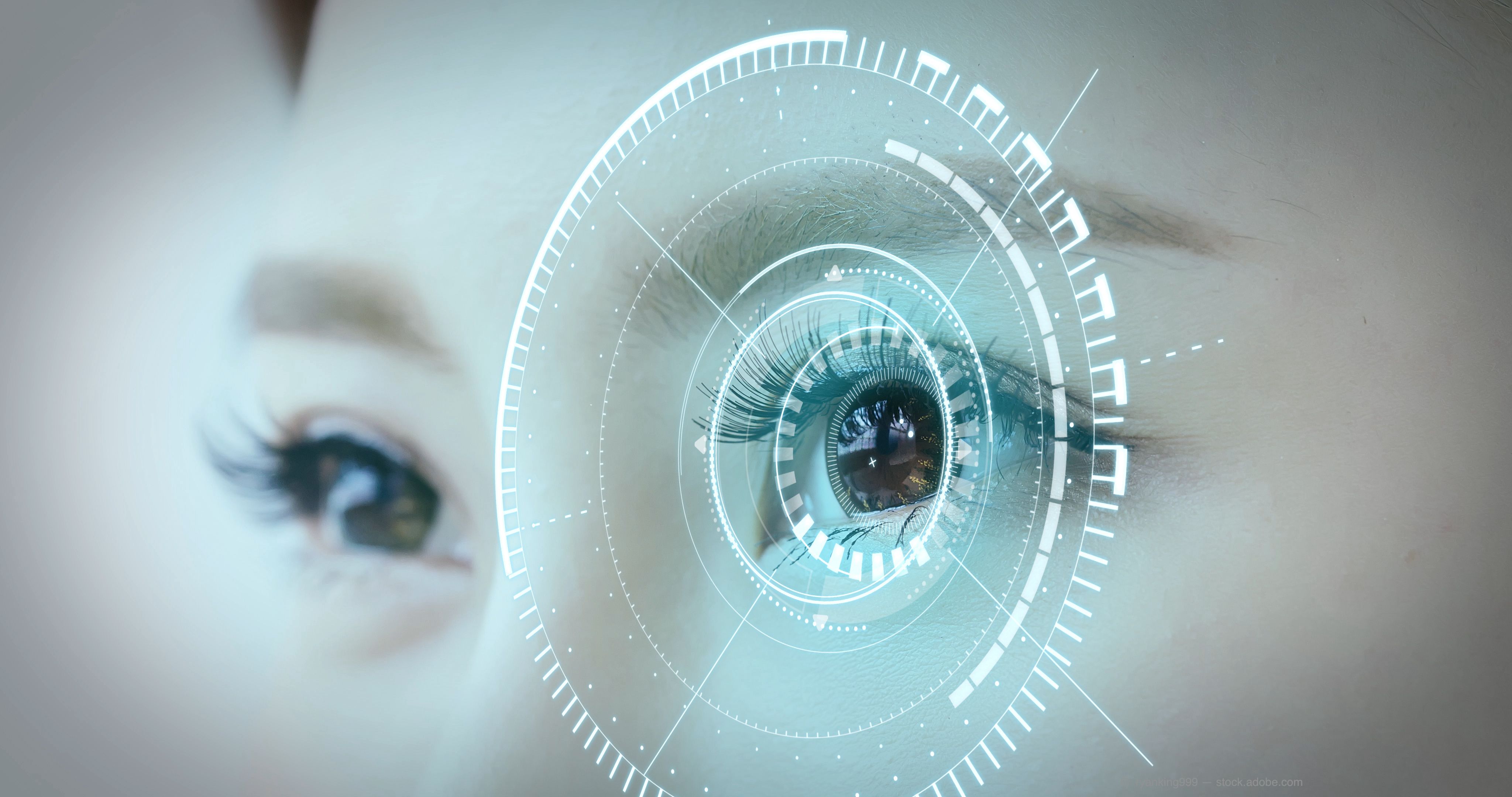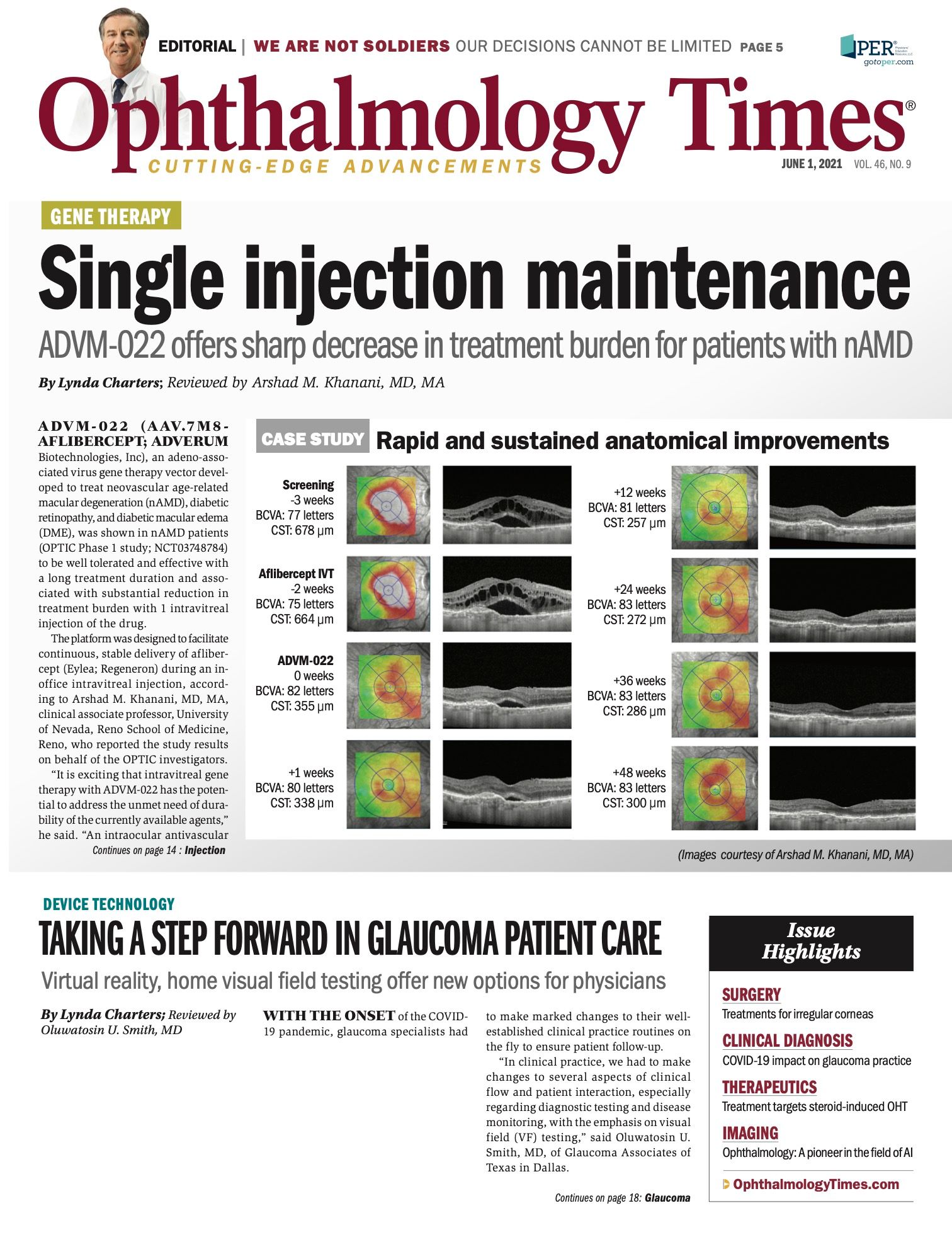Publication
Article
Digital Edition
Taking a step forward in glaucoma patient care
Author(s):
Virtual reality, home visual field testing offer new options for physicians.

Reviewed by Oluwatosin U. Smith, MD
With the onset of the COVID-19 pandemic, glaucoma specialists had to make marked changes to their well-established clinical practice routines on the fly to ensure patient follow-up.
“In clinical practice, we had to make changes to several aspects of clinical flow and patient interaction, especially regarding diagnostic testing and disease monitoring, with the emphasis on visual field (VF) testing,” said Oluwatosin U. Smith, MD, of Glaucoma Associates of Texas in Dallas.
Related: Measuring visual fields with a cloud-based AI platform
Diagnostic testing/monitoring
Before the pandemic, long office wait times for patients were commonplace for routine follow-up visits. Because of the pandemic, she pointed out, testing and visits were separated and testing centers were designated in some facilities.
Regarding VF testing, requirements were implemented for cleaning of equipment and time between patients after each VF test, which resulted in prolonged delays in the office. In an effort to reduce the wait times, virtual VF testing and home VF tests were implemented.
“When considering perimetry needs,” she said, “a number of factors are considered that include the reliability, reproducibility, and quantitativeness of the test; the efficiency and safety for physicians and patients; affordability; comfort; and ease of both use and cleaning. Virtual reality and home VF tests meet some of those criteria.”
Related: The challenges of examining visual fields in children
Available technology
Various devices are available commercially and include head-mounted devices, referred to as virtual reality perimetry, such as the VisuALL S for office use and the VisuALL H for home use (both from Olleyes), IMO (Crewt Medical Systems), and the C3 Field Analyzer (Remidio).
VF testing is available in different strategies; the visual acuity assessment is usually included in most available systems, as is threshold/suprathresold testing.
The size V stimulus test is not currently available. Adult and pediatric tests are available in specific devices.
The Olleyes VisuALL System has the advantages of being lightweight and portable; it offers goggle technology with a flat screen with each eye stimulated by an individual screen and threshold and suprathreshold strategies.
Related: A menu of glaucoma treatments includes options to fit all scenarios
Smith recounted a recent study that compared the Olleyes VisuALL with standard automated perimetry.1
The study included 102 eyes of 25 healthy patients and 26 patients with mild to moderate glaucoma. All participants were evaluated with both tests.
The authors reported that the test time was longer than with the Humphrey Field Analyzer (HFA) for both the normal subjects (6.13 minutes) and patients (9.28 minutes) (P = 0.02 and P < .001, respectively).
The investigators found a significant correlation of the global mean sensitivity of the HFA and VisuALL in normal subjects (P = .001) and patients (P < .001).
The VisuALL mean sensitivity had a greater receiver operating characteristic curve than the HFA mean sensitivity for discriminating normal eyes from glaucomatous eyes (P = .06).
Related: Optimizing and modifying newer glaucoma surgeries
Smith said the VisuALL system had lower peak brightness and lower background illumination than the HFA and an eye tracker that was similar in technology to the Octopus 600 (Haag-Streit).
It provided full threshold testing vs standard automated perimetry testing but required more time than the HFA because of the absence of a normal database and a frequency-of-seeing curve.
The printout of the VisuALL system is formatted like that of the HFA printouts. Using the VisuALL system, 1 eye can be tested, or both eyes simultaneously.
The system provides a full threshold test, which the IMO does not; the IMO has a special algorithm that helps improve the accuracy and speed of testing.
Studies to determine patient preference for the tests, repeat test performance, clinical utility, and normal database are underway.
Related: Glaucoma care after COVID-19: The Pan-American view
The devices are easy to clean after each use and multiple devices can be used at the same time. A technician is not necessary to monitor use of the device but is available if needed.
The testing can be performed in any position and location. Importantly, ease of use facilitates more frequent testing, which can rapidly detect VF progression.
The VisuALL H system is a head-mounted device that can be bought or rented. The web-based test is similar to the in-office test. Patient instruction and training are required.
The important advantages of virtual reality field tests are efficiency, safety, the ability to be worn over glasses, and ease of use; the major disadvantages include the potential for patient disorientation when wearing the goggle headset, preference for standard perimetry, possible high cost, and the fact that more clinical studies are needed to test the device with advanced glaucoma and with size V test objects.
Related: Intersection of glaucoma and retina at the pars plana
The Melbourne Rapid Fields (MRF) device (M&S Technologies) provides portable tablet-based perimetry.
When using the MRF, the patient can wear their own glasses. The software includes fixation and fast thresholding using Bayes logic. This perimetry device is available for use in the office and for home VF testing.
The MRF provides a printout similar to the HFA, 1 or both eyes can be tested at the same time, the stimulus size, ranging from the equivalent of size III to size IV depending on the degree of eccentricity, is adjustable during testing to allow for the tangent effect of a planar screen, and the test requires that the patient maintain a certain distance from the screen.
A study2 that included 12 normal eyes and 78 eyes with glaucoma and compared the MRF with the HFA in glaucoma patients found a high correlation between the 2 devices and comparable test-retest reliability.
Related: Managing secondary glaucoma due to intravitreal steroids
Another study3 that compared the MRF and the HFA in 60 patients with stable glaucoma or ocular hypertension over 6 months reported that the 2 were strongly correlated with each other over 4 visits and had good test-retest reliability.
The MRF designed for home testing sends a link to the patients and allows testing to be performed on the patients’ own devices.
Some calibration is required and testing is performed from a specific distance from the screen. There is a slight learning curve associated with this test.
The greatest advantage of portable tablet VF testing is that the home test can be performed on the patient’s own tablet or computer.
The disadvantages are that the size V stimulus test is not available, there is some patient discomfort with the positioning required, and a home test is technically more challenging to perform because of the required calibration.
Related: Controlling glaucoma uncertainty as COVID-19 limitations continue
Smith explained that the virtual reality fields and home VFs are valuable additions to the future of office perimetry, telemedicine, remote patient monitoring, and screening.
“The devices have been correlated with the established perimetry method, the Humphrey VF test,” she concluded. “There is need for improvement in the diagnostic and disease progression monitoring capabilities, and validation of use for more advanced disease is ongoing for the devices commercially in the US. Home monitoring VF devices may identify rapid VF progression.”
--
Oluwatosin U. Smith, MD
e:tsmith@glaucomaassociates.com
This article is adapted from Smith’s presentation at the American Glaucoma Society’s 2021 virtual annual meeting. Smith has not financial interest in this subject matter.
--
References
1. Razeghinejad R, Gonzalez-Garcia A, Myers JS, Katz LJ. Preliminary report on a novel virtual reality perimeter compared with standard automated perimetry. J Glaucoma. 2021;30(1):17-23. doi:10.1097/IJG.0000000000001670
2. Kong YXG, He M, Crowston JG, Vingrys AJ. A comparison of perimetric results from a table perimeter and Humphrey Field Analyzer in glaucoma patients. Transl Vis Sci Technol. 2016;5(6):2. doi:10.1167/tvst.5.6.2
3. Prea SM, Kong XYG, Mehta A, et al. Six-month longitudinal comparison of a portable tablet perimeter with the Humphrey Field Analyzer. Am J Ophthalmol. 2018;190:9-16. doi:10.1016/j.ajo.2018.03.009

Newsletter
Don’t miss out—get Ophthalmology Times updates on the latest clinical advancements and expert interviews, straight to your inbox.




